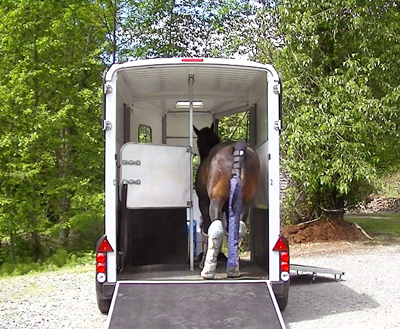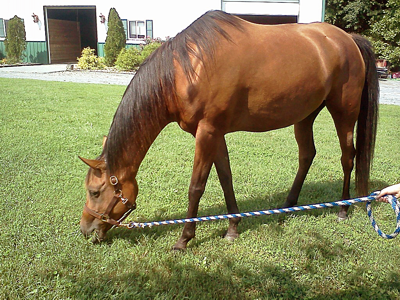Transport of Horses
There are records of transporting horses by sea dating back into ancient history. Horses were an important part of trade, travel and military operations and transporting them without harm became very important. There is now a lot of research into the theories of transportation, considering issues such as the way the horses face, whether tied or loose and the frequency of rest stops.
 In 1066 William the Conqueror brought over two thousand horses across the channel as part of his invasion force. There are records of horses being stabled on deck in wooden stalls, supported by canvas slings and apparently arriving in good condition. Travel below deck was associated with a high mortality; the air quality would have been very poor, damp and inadequately ventilated. They recorded the use of leg wraps and boots, along with padding for protection of the head. There was also specific reference to the provision of hay and water in suitable quantities. Over the centuries the means of transporting horses have changed considerably and although the head guards have largely become unnecessary, many of the principles remain the same.
In 1066 William the Conqueror brought over two thousand horses across the channel as part of his invasion force. There are records of horses being stabled on deck in wooden stalls, supported by canvas slings and apparently arriving in good condition. Travel below deck was associated with a high mortality; the air quality would have been very poor, damp and inadequately ventilated. They recorded the use of leg wraps and boots, along with padding for protection of the head. There was also specific reference to the provision of hay and water in suitable quantities. Over the centuries the means of transporting horses have changed considerably and although the head guards have largely become unnecessary, many of the principles remain the same.
Health considerations
Protection of the legs is still a very important element of travelling horses and routine fitting of ‘touch & close’ strapped boots saves many injuries, from the horse itself (particularly if shod) and from partitions in the vehicle. From a veterinary point of view, the most frequent involvement we have with the many short journeys that occur, is a consequence of cuts, grazes and bruises to the head and legs of the horses. These can be very frustrating for all and potentially prevent participation in the event to which the horse was travelling.
Travelling has an effect on the immune system of the horse, and the longer the journey, the worse the impact will be. This lowers the horse’s resistance to developing infections, particularly of the respiratory tract, which is challenged by the dust from the road and from any hay that may be fed on the journey. The respiratory system is at its best when the horse is grazing, as the head down position prevents build up of mucus in the airways. Travelling with the head up for long periods in a challenging environment can lead to respiratory disease, which can be as little as a cough developing after the journey, or may be as serious as a life threatening pleuropneumonia.
The airways of a horse are protected from challenge by a complex process that involves a physical removal of material up the trachea, together with specific immune action that destroys pathogens that may do harm. Dehydration reduces the ability to clear debris from the lungs and the upright position of the head makes this worse. The stress of transport and its effect on the immune system makes such infections more likely. Frequent stops are warranted on long journeys, allowing you to muck out and walk the horses out. Short stops are not enough to allow clearance of mucus from the lungs so allow a reasonable stop, when food and water should be offered on the ground. 
If horses don’t drink regularly through the journey, dehydration will have a further impact on the challenge to their health. The young and old are particularly at risk.
So bearing these points in mind
• Transport only healthy horses where possible
• Protect their extremities in a vehicle that is suitable and well maintained
• Provide food and water on the journey
• Remove faeces and urine regularly
• Ventilate well but protect against exposure to road dust and debris
• If necessary and for longer journeys, travel with a companion
• Allow adequate rest periods, ideally where the horse can graze safely
• Regulate temperature, rugs to keep them warm in cold weather and ventilation if hot
• In extreme heat, consider transporting at night
• Always carry the horses’ passport(s)
On arrival at the destination
Take into account the experience of the horse, as regular travellers may cope well, but higher risk animals should be watched closely
A thorough inspection of the horse should be carried out at the earliest opportunity. Assess dehydration, in extreme cases intravenous fluids may be required. Wash any scrapes or grazes and treat as needed.
Monitor rectal temperature after long journeys and seek veterinary help if there is any doubt. In the UK this applies particularly to horses arriving from the continent by lorry. Many young, future competition horses are travelled by this route and any lung disease that may develop as a result can have a significant impact on their future career. Horses tolerate air travel remarkably well and this offers a good alternative to the long road journey from a health point of view, but at a cost.
Trials have been carried out giving antibiotics and anti-inflammatory drugs before long distance travel. It has been found this treatment does little to prevent the development of serious disease, which may take as long as three weeks to come to the surface.
If travelling ill or injured horses for treatment, the specific needs must be addressed in detail. Treatment will be started before the journey and will be in place to maximise the support for the horse. Distances should be kept to a minimum and slings, as are fitted in equine ambulances, may be considered necessary. Many vehicles are fitted with CCTV cameras, which do away with the old, hazardous practice of travelling a groom in with the horses.



